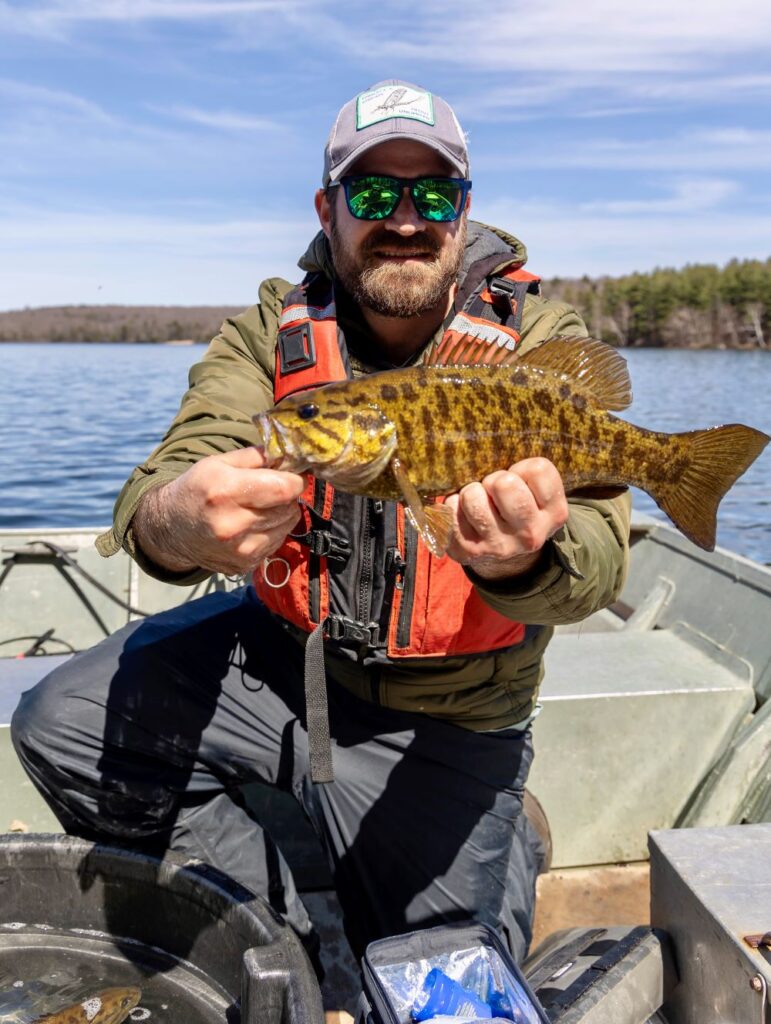Wangum Lake Helps Restore the Fisheries in Connecticut Lakes
State fishery biologists work to keep our waters and fish healthy

Andrew Miano, a fisheries biologist with Connecticut Department of Energy and Environmental Protection (CT DEEP), holds a Wangum Lake smallmouth bass,
By David Beers
Wangum Lake, Norfolk’s own water-supply reservoir, has the densest population of smallmouth bass of any Connecticut lake, according to Andrew Bade, a fisheries biologist with the Department of Energy and Environmental Protection (DEEP). Even though the Aquarion Water Company, which owns the reservoir, does not allow fishing at Wangum Lake, bass from Norfolk are helping restore smallmouth bass in other Connecticut lakes – to the benefit of anglers.
Sportfishing is a multibillion-dollar industry, with bass the most sought-after sport fish in the United States. Largemouth and smallmouth bass are popular for anglers because they have the most fight in them, especially smallmouth. Largemouth and smallmouth are the bass found in Connecticut, where they act as the main predator fish in our lakes, streams and rivers. As predators, bass play a key role in maintaining healthy fish communities. And yes, largemouth do have a larger mouth that extends past their eyes. There are a variety of other characteristics (color, markings, fins) that distinguish the two species from each other.
Smallmouth bass prefer more sparsely vegetated habitat and clearer water than largemouth. They are also more sensitive to pollution and spikes in water temperature. Eutrophication in some of our lakes has also favored largemouth to the detriment of smallmouth. Eutrophication occurs when an overabundance of nutrients from runoff increases microbe populations and decreases dissolved oxygen in the water, eventually resulting in acidification and loss of aquatic life. This has happened in some Connecticut lakes whose healthy populations of smallmouth bass were lost or diminished. Improved habitat conditions in some lakes in eastern Connecticut have made them candidates for the reintroduction of smallmouth bass.
Of course, reintroducing fish requires a fish source. CT DEEP, in cooperation with Aquarion, decided Wangum Lake would be that source. In addition to the highest density of smallmouth in Connecticut, Wangum is possibly the only large Connecticut lake that has no competing population of largemouth bass. This is probably one reason why the density of smallmouth is so high. The Wangum bass also tested negative for largemouth bass virus, which means that any transported fish will not infect other lakes with this undesirable bass sickness.
Bade is confident that the Wangum smallmouth population will quickly recover from any fish removals because of their high abundance, excellent habitat and the lack of competing largemouth. There will also be no impact on sportfishing given the fact that Aquarion does not allow fishing at Wangum. Bade noted that the removal will have no effect on drinking water quality.
Of the seven lakes targeted for smallmouth reintroduction, Wyassup Lake in North Stonington was chosen as the first lake for this pilot project. This past April, 160 fish were transported from Wangum to Wyassup in a CT DEEP fish transport tanker. Wyassup is about half the size of Wangum and at the opposite corner of the state. Of the seven lakes under consideration for reintroduction, Wyassup has the best habitat for smallmouth, which is a gravel/cobble bottom needed for spawning. Wyassup traditionally had a large population of smallmouth.
Acting as an Uber-Fish driver is not all the only step taken by CT DEEP to ensure a successful re-introduction. They are also working on habitat improvements on the Wyassup lake bed for smallmouth by providing a hangout space and spawning boxes. The first is called a half log, which is a log split in half with cinder blocks fastened at each end to keep the split end a few inches above the ground. Smallmouth like to hang out in this overhead cover that looks like a steeplechase jump. The second are nest boxes for spawning, wood-framed squares filled with gravel that look like raised garden beds.
Bade is hopeful that the pilot project to reintroduce smallmouth to Wyassup Lake will be a success. If all goes well, Bade would like to see smallmouth reintroduced into other lakes that are ready for their return, but also lakes in need of a “shot-in-the-arm” supplementation of smallmouth to get their population up to the level of a healthy sustainable fishery.
